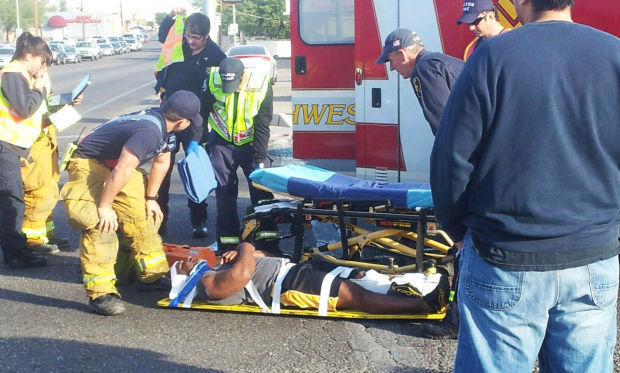The man lay on the asphalt of East Grant Road, groaning beneath a cluster of firefighters, his bicycle perched on the sidewalk nearby.
Another day, another cyclist struck on Tucson’s dangerous roads.
It was about 8:45 Tuesday morning, and I happened upon the scene at Grant and Stone, where a man driving a Pontiac turned right and struck the cyclist, who was crossing Grant northbound at the light. This time, the driver was going slowly, so the injuries were minor.
Too often, that’s not the case.
Coincidentally, the next day a group of legislators, attorneys, cycling activists and others gathered at the midtown law office of Eric Post, where shattered bike frames are piled here and there. Cases of bicyclists struck by cars make up 80 percent of Post’s legal work, he says.
Post, State Sen. Steve Farley, State Rep. Ethan Orr and others are coming up with proposals to help make the streets safer for pedestrians, bicyclists and other “vulnerable road users.”
The record number of pedestrian deaths in the Tucson area — 21 so far this year — along with the steady drumbeat of bicycle collisions show now is the time to take action. If Tucson and Arizona are to keep their place as havens for bicyclists — a reputation underlined by the arrival of 8,600 cyclists for El Tour de Tucson this weekend — the body count must come down.
The big legislative effort could be for a vulnerable-road-user law, like the ones that five other states have. Farley, a Tucson Democrat, and Orr, a Tucson Republican, are considering introducing a bill that would set new penalties for drivers at fault for hitting pedestrians, bicyclists and perhaps some others such as motorcyclists.
But it’s an iffy proposition, in part because divisions remain from last session, in which moderate Republicans and Democrats united to pass Gov. Jan Brewer’s budget and Medicaid legislation. Orr was one of the Republicans who went with Brewer and against the Legislature’s Republican leaders.
“I’m already pitching bills to the leadership,” Orr said Wednesday. But this coming session, he said, “Let’s get one win, then come back the next year and get two.”
Smaller possibilities would be administrative changes, or simply changes in approach from the authorities who enforce traffic laws. The Arizona Department of Public Safety has already announced it plans to crack down on distracted driving, by citing those who are, for example, texting while driving for going at a speed “not reasonable or prudent,” Farley said.
Another change would be to include more bicycle and pedestrian information in driver’s education courses, Farley said.
Tucson police have improved considerably in their approach to bicycle-involved crashes in recent years, local attorney and cyclist Erik Ryberg told me.
“I used to get so many cases of cyclists who were hit when they were doing a completely lawful act, but they are blamed for it,” Ryberg said. “The (TPD) personnel changed, and there’s a different attitude in the department.”
“It’s easy to pick on the city of Tucson for various errors, but overall they’re getting better.”
In fact, Tucson police are in discussions with the Governor’s Office of Highway Safety for an initiative to focus on pedestrian and bicycle safety, spokeswoman Sgt. Maria Hawke said.
But it won’t — and shouldn’t — just be drivers who are the focus of the efforts. Bicyclists and pedestrians, too, need to wake up to their own vulnerabilities.
“The biggest thing is they fail to recognize there is no force-field around a crosswalk,” Hawke said. “Yes, you’re in the right, but when it’s a vehicle versus you, you’re going to lose.”
It’s unclear who was at fault in the crash I came across Tuesday, and TPD didn’t have any information on citations.
The bicyclist had ridden from the sidewalk along Stone — really, a long row of paved driveways and parking lots — into the crosswalk on Grant, where he was hit.
No matter whose fault it was, it’s clear who was the loser.





